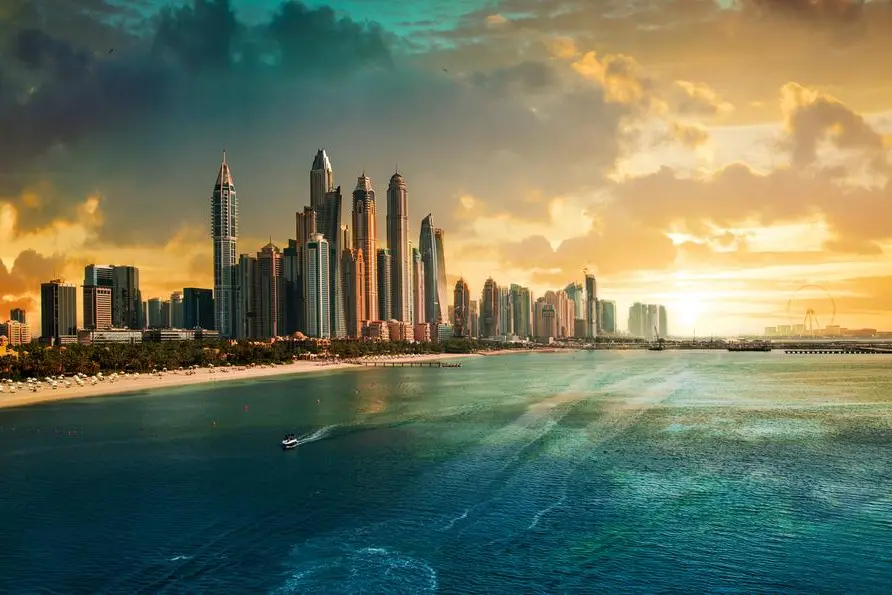Dubai Skyline has become one of the most recognized symbols of modern architecture in the world. From the soaring Burj Khalifa to the futuristic Dubai Frame, the skyline reflects ambition, creativity, and innovation. It tells the story of a desert city that transformed itself into a global hub for business, culture, and luxury.
Today, the Dubai Skyline is more than just tall buildings. It is an identity, a landmark, and a global brand that represents progress, ambition, and the power of vision.
Dubai Skyline: From Desert Town to Global City
Only a few decades ago, Dubai was a modest trading hub along the Arabian Gulf. The landscape was filled with low-rise buildings, traditional souks, and desert surroundings. But with visionary leadership and bold investments, the city redefined its future.

The construction of the Burj Khalifa, the tallest building in the world, marked the beginning of Dubai’s global recognition. Since then, skyscrapers like the Burj Al Arab, Cayan Tower, and Jumeirah Emirates Towers have turned the Dubai Skyline into a breathtaking panorama.
The skyline now stands as a symbol of ambition, proving that no dream is too big for the UAE.

The Burj Khalifa: Jewel of the Dubai Skyline
At the heart of the Dubai Skyline is the Burj Khalifa, standing at 828 meters. This architectural wonder is not only the tallest building in the world but also a global tourist attraction.
Visitors from across the world travel to Dubai just to see the Burj Khalifa, whether it’s to dine at its luxury restaurants, visit the observation decks, or watch the famous fountain shows at its base.
The Burj Khalifa has become the crown jewel of the Dubai Skyline, representing the city’s rise as a leader in architecture and innovation.
Architectural Diversity
One of the reasons why the Dubai Skyline is admired worldwide is its architectural diversity. Unlike many other cities where skyscrapers follow similar designs, Dubai embraces creativity and uniqueness.
Some remarkable landmarks include:
- Burj Al Arab: Designed to look like a sail, it is one of the world’s most luxurious hotels.
- Cayan Tower: Famous for its twisting design, showcasing engineering excellence.
- Dubai Frame: A golden structure that frames views of both old and new Dubai.
- Museum of the Future: A futuristic landmark blending design, technology, and culture.
Each building contributes to the city’s skyline, making it one of the most photographed in the world.
Dubai Skyline as a Symbol of Innovation
The Dubai Skyline reflects more than just luxury—it is also about innovation. Buildings in the city are designed with advanced technologies, sustainable features, and futuristic designs.
For example, the Museum of the Future is covered in Arabic calligraphy and built using advanced 3D construction methods. Many skyscrapers also integrate smart technology to improve energy efficiency and reduce environmental impact.
This focus on sustainability shows how the Dubai Skyline is shaping the future of global architecture.
Dubai Skyline at Night: A City That Glows
At night, the Dubai Skyline transforms into a magical sight. Illuminated towers, colorful lights, and reflections over the water create one of the most beautiful nightscapes in the world.
The Dubai Fountain Show, set against the Burj Khalifa, attracts thousands of visitors every evening. Similarly, the Ain Dubai observation wheel offers stunning views of the glittering skyline, making it a must-visit attraction.
This nighttime beauty has earned Dubai the title of a city that never sleeps, with its skyline shining as brightly after sunset as during the day.
A Tourism Magnet
Tourism plays a big role in Dubai’s economy, and the skyline is one of its biggest attractions. Millions of visitors each year are drawn to iconic landmarks, rooftop restaurants, and sky lounges with panoramic views.
The skyline also appears in countless movies, advertisements, and travel campaigns, further strengthening Dubai’s reputation as a global destination. For many travelers, seeing the Dubai Skyline is as memorable as visiting Paris’ Eiffel Tower or New York’s Times Square.

The Future of the Dubai Skyline
The Dubai Skyline continues to evolve, with new projects pushing architectural boundaries. Some upcoming additions include:
- Dubai Creek Tower: Planned to be even taller than the Burj Khalifa.
- One Za’abeel: Featuring the world’s longest cantilever connecting two towers.
- New sustainable skyscrapers designed to reduce energy consumption and integrate green spaces.
These projects will ensure that the Dubai Skyline remains a symbol of ambition and creativity for years to come.
Why the Dubai Skyline Is a Global Icon
The Dubai Skyline is not just about tall buildings—it is about vision, culture, and global influence. It represents how a city can transform itself through determination and forward-thinking leadership.
The skyline stands as:
- A symbol of ambition: Proving that bold ideas can become reality.
- A center of innovation: Embracing futuristic designs and technology.
- A tourism icon: Attracting millions of visitors annually.
- A cultural landmark: Blending traditional elements with modern architecture.
Conclusion
The Dubai Skyline has earned its place as a global icon by combining creativity, engineering, and vision. From the tallest tower in the world to architectural wonders that defy imagination, the skyline tells the story of a city that turned dreams into reality.
As new projects rise, the Dubai Skyline will continue to inspire cities worldwide. It is more than just a skyline—it is a symbol of innovation, ambition, and the limitless possibilities of the future.
Do follow UAE Stories on Instagram














